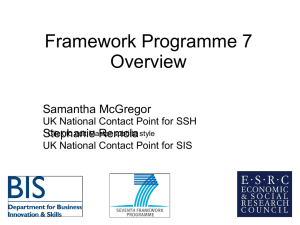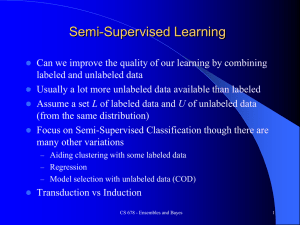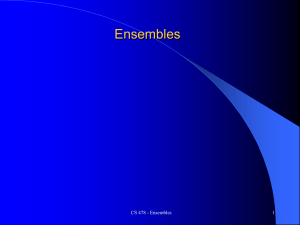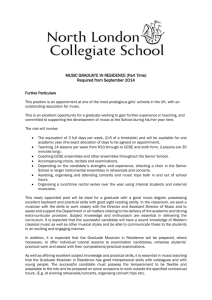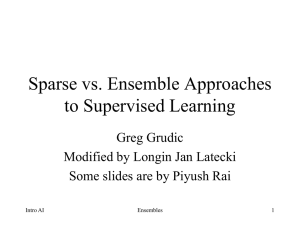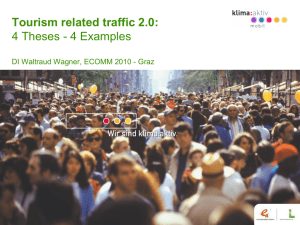Software Components in Computer Assisted Living?
advertisement
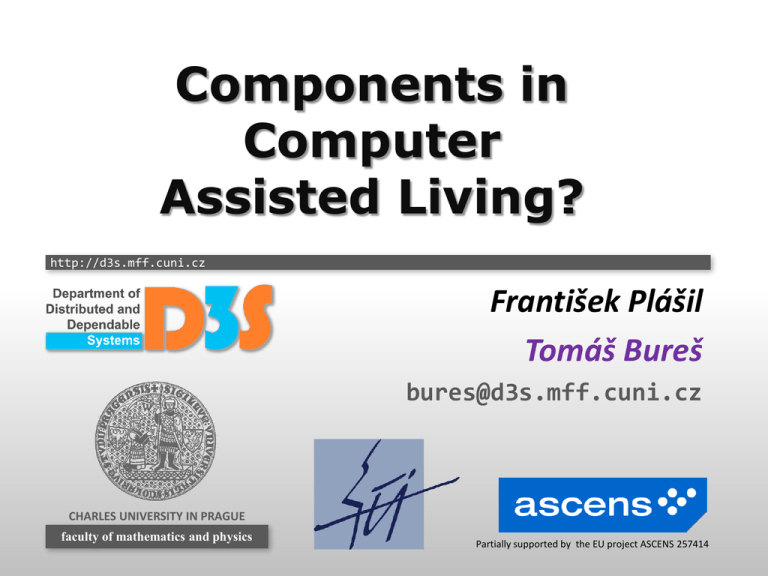
Components in
Computer
Assisted Living?
http://d3s.mff.cuni.cz
František Plášil
Tomáš Bureš
bures@d3s.mff.cuni.cz
CHARLES UNIVERSITY IN PRAGUE
faculty of mathematics and physics
Partially supported by the EU project ASCENS 257414
Context
Example: Road Trains
[FP7 project SARTRE]
Application Contexts in General
… Smart phones and on-body systems to communicate in changing and
mobile environments that offer users access to information and services
while on the move;
Homes, cars and offices, that offer systems and solutions for improved
enjoyment, comfort, wellbeing and safety ...
Adapted from [ARTEMIS AWP 2012]
2
Priorities (EU FP7 ICT)
FP7 ICT challenges:
1. Pervasive and trusted network and service infrastructures
• Internet of Things, Internet of Services
2. Cognitive systems and robotics
3. Alternative paths to (hardware) components and systems
4. Technologies for digital content and languages
5. ICT for health, ageing well, inclusion and governance
6. ICT for a lower carbon economy
7. ICT for the enterprise and manufacturing
8. ICT for learning and access to cultural resources
[FP7 ICT WP 2013]
3
Goal of the Talk
Do we know how to develop such systems
(for “computer assisted living”)?
In particular judging from perspective of
component-based software engineering
System realization using components
Design process
Resume
Classical methods do not scale
There are new alternative approaches which scale better
Component ensembles, Invariant-based design process
4
Structure of the Talk
Case-studies
Realization using components
Classical approaches
Ensembles of components
Design process
Classical approaches
Invariant-based approaches
5
Example: E-mobility
ASCENS EU project (FP7 IP FET)
Goal: Self-aware, self-adaptive
systems from components
Partners: LMU, Fraunhofer, VW, EPFL,
VERIMAG, UNIPI, UDF, CUNI, UL, IMT,
UNIMORE, ULB, Zimory, Mobsya, ISTI,
CNRS, INPG
[FP7 project ASCENS – Deliverable D7.1 (VW Demonstrator)]
Key Aspects
• Open-ended
• Dynamic
(Physical world)
• Autonomous
• Adaptive
• Emergent behavior
6
Example: Cloud computing
[FP7 project ASCENS – WP7.2 Demonstrator]
Key Aspects
• Open-ended
• Dynamic
(Virtual world)
• Autonomous
• Adaptive
• Emergent behavior
7
Software Which Adapts to Environment
Component architecture has to constantly change
to reflect the situation in the outer world
e.g. a new car appears in the
world
e.g. a new passenger sharing
a car
8
Realization via Components:
Classical Approaches
Why don’t they scale …
9
Classical Component-Based Approach
Centralized ownership & deployment
Cannot capture dynamic changes in architecture
Guaranteed communication needed
Strong reliance on other components
10
Service-Oriented Approach
3-rd party ownership & deployment
Dynamic architecture (via service-driven discovery)
Guaranteed communication needed
Strong reliance on other services
11
Agent-Based Approach
3-rd party ownership & deployment
Dynamic architecture (via agent-driven discovery)
Guaranteed communication needed
Autonomous (beliefs – desires – intentions)
Agents bring conceptual autonomy
But do not sufficiently translate it to
proper software engineering constructs
12
Realization via Components:
Component Ensembles
What they are …
Why do they scale better …
13
Component Ensembles
Featured by ASCENS project
Stem from coordination languages KLAIM, SCEL
Implicit architecture (DEECo component model)
Described by interaction templates
When to communicate
Scope: rapid dynamism,
non-guaranteed communication
What to communicate
Easier development,
Apps more robust
Communication: data sharing
Asynchronous … belief
14
E-Mobility Case Study
[Volkswagen & Charles University]
15
E-Mobility Case Study
Component Vehicle = {
id: Id=”V1”
position: IPosition
availablePLCS: IPLCS
userSchedule: ISchedule
currentPlan: IPlan
…
process updatePlan {
function = updatePlan
inputKnowledge = [position,
availablePLCS, userSchedule, …]
outputKnowledge = [currentPlan, …]
scheduling = periodic(1s)
}}
Component PLCS = {
id: Id=”PL1”
freePlaces: Int
position: Iposition
bookings: Map[Id, IBooking]
…}
[Volkswagen & Charles University]
Interface IPLCS={
id: Id
freePlaces: Int
position: IPosition
}
Ensemble PLCSDiscoveryEnsemble{
member: IVehicle
coordinator: IPLCS
membership =
proximity(m.position, c.position) <= DIST_THR &&
m.freePlaces >= FREE_PLACES_THR
minimize proximity(m.position, c.position)
m->c mapping {
c.availablePLCS = c
}
}
16
E-Mobility Case Study
[Volkswagen & Charles University]
Prototype of the demonstrator
Video …
Developed in jDEECo
http://github.com/d3scomp/JDEECo
17
Component Ensembles
Can be seen as a system of conditionally interacting
MAPE-K loops
MAPE-K Loop
- Central concept of
autonomic computing
- Introduced by IBM
18
Component Ensembles – Summary
3-rd party ownership & deployment
Dynamic architecture
framework does discovery, transparent to component
Rapid dynamism & non-guaranteed communication
Autonomous (beliefs – desires – intentions)
What about component abstractions?
Ensapsulation
Substitutability
Reusability
a component can’t access another one
knowledge forms the interface (semantics)
architecture externalized to ensembles
19
Design process
20
Design Process
Problem:
Component ensembles have relatively exotic
computational model
Very far from classical procedure call-based sequential
programming
Method for high-level design are necessary
Requirements
…
Components + Ensembles
21
Detour: Resilient Systems
“A resilient control system is one that maintains
state awareness and an accepted level of
operational normalcy in response to disturbances,
including threats of an unexpected and malicious
nature”
[wikipedia]
22
Resilience
System adaptability
System evolvability
Impact on external environment
Cooperative aspects
23
Design of Resilient Systems
with Classical SE Approaches
Why don’t they scale …
24
Classical Approaches
Use-cases, User stories, …
Use-case Example
Schedule meeting
1. User enters the possible dates of the meeting
2. Use enters e-mails of the participants
3. System validates the e-mail addresses
4. System sends an e-mail with an invitation to each participant
5. System confirms e-mails being sent
…
Problem?
Describes “how” instead of “what”.
Inherently less adaptable/evolvable.
25
KAOS Model – System Goals
Problem?
Describes what is to be achieved, does
not speak about the present moment.
“In what relation is the system to its
environment and to itself right now?”
26
Promising directions?
What is promising to scale better …
27
SOTA Model
28
Predicate Refinement Model
29
Challenges: Different Levels of Abstraction
High-level of abstraction ~ describe goal
Low-level of abstraction ~ results of processes,
ensembles
Non-crisp semantics
Predicates do not have to hold “always”
Predicates do not have to hold “completely”
New types of logic need:
Relaxes the system requirements ~ better efficiency
Hints the system of “closest” acceptable state
30
Conclusion
31
Conclusion: Where Do We Stand?
Mature methods for:
modeling relatively static systems by components,
services
distributed algorithms using agents
closed distributed soft-realtime systems
analysis of such static systems
e.g. timing analysis, functional properties, …
goal-oriented design processes
32
Conclusion: What Do We Need?
New methods for:
development (using components) of distributed
autonomous systems with emergent behavior
e.g. intelligent navigation in e-mobility, adaptive scaling in adhoc clouds
design process of autonomous systems
based on describing the expected state down to the level of
components / ensembles
33
Roadmap – Short Term Priorities
We need to elaborate more on
Component self-awareness and adaptation based on
high-level goals and strategies
Techniques and models with a proper level of
abstraction for feasible testing and verification of
correctness of components with emergent behavior
Prediction and optimization techniques for achieving
efficient use of resources by distributed adaptive
components
Security aspects
34
Summary
Components in Computer Assisted Living?
From software perspective – we are not very far
and many things can be done already, we have to
combine existing approaches;
scale existing approaches and elaborate on new ones to
address the large open systems with emergent
behavior;
focus on how to employ the existing techniques in
software engineering
35

